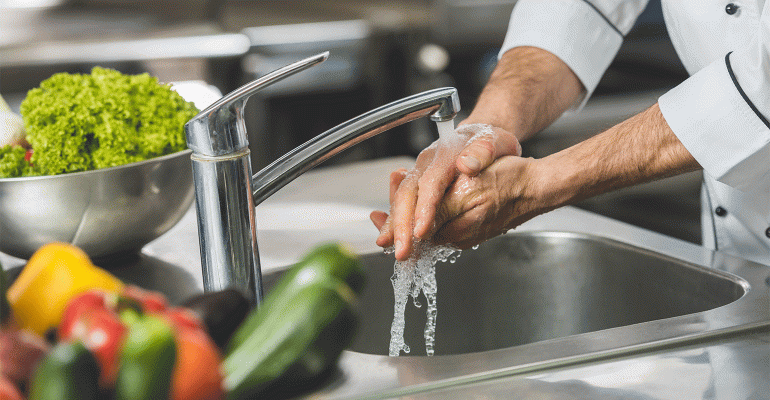The National Restaurant Association and ServSafe updated their COVID-19 guidance for businesses on Wednesday in conjunction with requirements and guidance from the Food and Drug Administration and Centers for Disease Control and Prevention to include best practices for safe layouts and ventilation. Now renamed the “COVID-19 Safe Operating Guidance,” the guidelines also update sections on employee personal hygiene and when and where face masks should be worn.
“This update reflects the latest proven science and best practices available for restaurants operating during this public health crisis,” said Larry Lynch, senior vice president for science and industry for the National Restaurant Association. “Restaurant operators are focused on creating safe and welcoming environments for their employees and patrons. […] These guidelines provide straight-forward practices — like wearing masks when not eating or drinking, keeping social distances, and staying home when sick — that help keep risk low for diners and employees.”
ServSafe is also suggesting that all employees are trained and certified in ServSafe’s Food Handler safety courses and have been educated on the organization’s COVID-19-era precaution trainings.
Here are some of the updated rules and guidelines for restaurant operators:
Layouts
The guide suggests modifying restaurant layouts by limiting capacity, adding barriers like sneeze guards and partitions between tables, as well as physical guides for social distancing, which might include signage and tape on the floor to guide patrons to safely distance in common areas like bathrooms, bars and lobbies.
Ventilation
The American Society of Heating, Refrigerating and Air-Conditioning Engineers recommends having an HVAC technician test and/or repair your current ventilation system, conduct a test of the unit every 3-5 years, verify that any outdoor units have properly functioning dampeners, filters, coils, drain pans and fans.
These guidelines, which follow common sense procedures, do not necessarily recommend replacing your HVAC unit, though other states and cities like New York City are recommending businesses upgrade to MERV-13 units or equivalent.
Technology
The National Restaurant Association recommends using new and improved technologies to limit the spread of germs and to communicate effectively with customers including contactless payment systems, automated ordering systems, mobile ordering apps and website updates that clearly state restaurant policies and options for customers concerned about either on or off-premise dining.
Personal hygiene/facial coverings
As per the updated guidelines, employees that feel sick should stay home and employers should use pre-work screenings (temperature checks and/or rapid testing) to determine if an employee should quarantine until they feel better. Working employees should never work with a temperature above 100.4 degrees.
If an employee is found to be sick, areas touched or used by the sick person should be closed and cleaned, sanitized and disinfected 24 hours after the ill employee or customer leaves the premises.
Facial coverings should be worn by employees, particularly when in areas when it’s impossible to maintain social distancing. The usage of gloves is discouraged for front of house employees and should not replace frequent handwashing.
Finally, ServSafe suggests posting signage in the restaurant to remind guests and employees about sanitation and hygiene rules and guidelines.
Contact Joanna Fantozzi at [email protected]
Follow her on Twitter: @JoannaFantozzi




